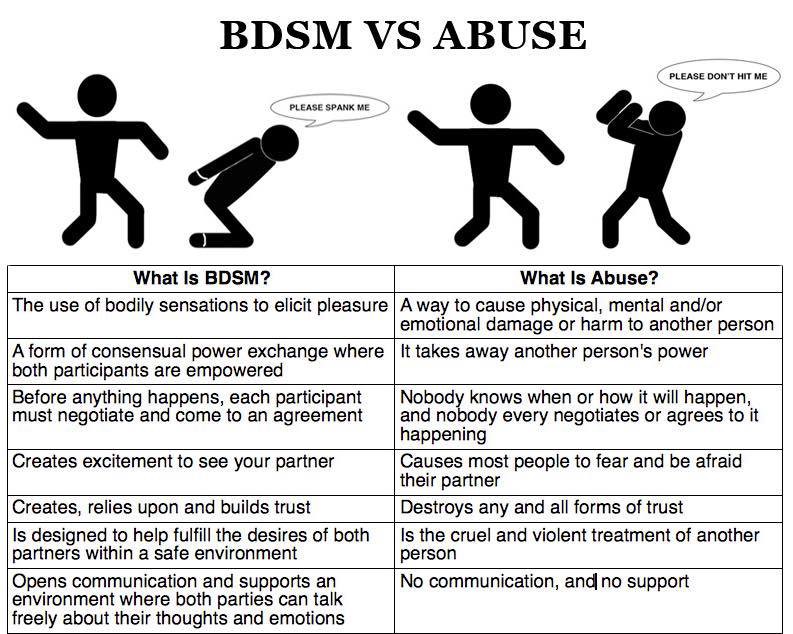It can be as simple or as technical as you want.
Maybe the thought of being tied up excites you, or you enjoy spanking or being spanked. Or maybe you’re more interested in leather masks and nipple clamps and hot wax. All of that (and obviously a lot more) is within the realm of BDSM. Basically, you can still be into kink without actually ever going to a dungeon.
Before you go past the VERY basics, do your research.
Using a blindfold or an ice cube or fuzzy handcuffs you got at a bachelorette party are all relatively harmless beginner behaviors if you’re into them. But before you play around with some of the trickier tools, you need to learn how to do so safely. Even a rope or a whip can be dangerous if you don’t know what you’re doing.
You can even mess up with your own hands (think: fisting): some people think they can clench a fist and stick it inside somebody. That’s a good way to really injure someone and send them to the hospital. Instead, try an enormous amount of lubricant and starting with two or three fingers, then slowly and carefully building up to the whole hand.
Seriously, BDSM involves A LOT of reading and learning
If you’re one of those people who throws away the directions and tries to build the bookshelf on intuition alone, BDSM is probably not for you. The vast majority of what we call BDSM education is how to maximize ecstasy and minimize risk. Educate yourself on how to do all the things you fantasized about doing and to do them safely.
While there’s no one required reading list, there seem to be a few favorites that are often recommended to beginners, like SM 101 by Jay Wiseman, Screw the Roses, Send Me the Thorns, by Phillip Miller and Molly Devon, and The New Topping Book and The New Bottoming Book by Janet Hardy and Dossie Easton.

Classes, conferences, and meet-ups are also helpful for learning specific techniques. Another popular resource is FetLife.com, a Facebook-like network for the kink community, which can connect you with message boards, groups, and classes in your area.
It’s important to get your information from a variety of sources
One mistake many people make when first experimenting with BDSM is relying on one person to show them the way. Even if they do have your best interest at heart (and they might not), it can be limiting to only have one perspective on something that is so multidimensional. Instead, seek out books, workshops, meet-ups, mentors, friends, message boards, and more to find a safe place to explore your interests.
When you can’t talk about what’s happening and you can’t make sense of your experience with like-minded people, that’s way more dangerous than the variety of activities you might fantasize about.
Safe words are definitely a thing
It might sound cheesy, but it’s a well-established norm in BDSM. (And hey, your safe word could actually be “cheesy” if you want. You do you.) Safe words are probably one of the most important norms that have spread across the community, even if people use them in different ways. For instance, not everyone uses safe words all the time after a while, but it’s important to start out with them. They can essentially be anything you want, as long as it’s something that you wouldn’t normally say during sex.
And at some public events, there are even safety monitors on duty
Dungeon monitors will kick out people who don’t look like they’re playing safely. This can be anything from ignoring safe words to using a whip incorrectly. Seriously, did we mention that safety is paramount here? In fact, the acronym SSC (safe, sane, consensual) is one of the most common pillars of the practice.

It’s not as spontaneous as Hollywood movies or porn make it out to be
Getting swept up in the moment and accidentally stumbling into a millionaire’s red room (where you’ll have multiple orgasms) is probably not going to happen to you ever. But, that’s not necessarily a bad thing. A sexual fantasy makes everything look so easy. People who actually do this stuff are very cautious about it. It has to be the right place and right time and right equipment. And you have to know you can get the person out [of whatever bondage] if there’s an emergency. You have to feel you can trust the person. So there’s a lot that goes into one scene, but that doesn’t mean it’s any less satisfying for those who enjoy it.
There’s also probably way more talking involved than there is with (most) vanilla sex
Whenever people question the role of consent in BDSM, they should consider the enormous amount of communication that occurs before, during, and after the scenes. Talk about what we want to do, what we’re going to do, what our fantasies are… that’s part of negotiating a good relationship as a BDSMer.
There’s actually a pre-negotiation period, where the partners discuss what they like, what they don’t like, and what they absolutely will not tolerate
Think of this as the primer before the scene. It’s a way of discussing the experience ahead of time that can increase emotional security. This can involve anything from scripts and checklists to a more informal discussion of what each person’s expectations are for the scene, what they want and don’t want, and any words or actions that are completely off-limits.
And then comes aftercare, the debriefing period that happens once the scene ends

Since BDSM can be an incredibly intense and emotional experience for some, most experts strongly suggest this wrap-up step, where the partners can discuss the scene and any reactions they had to it. People are extremely vulnerable during aftercare. It can be really weird to have a scene without it. This can also be a strong bonding experience between the partners.
BDSMers can be monogamous, polyamorous, or whatever the hell they want
Not everyone who’s interested in BDSM has multiple sexual or relationship partners. It used to be a popular perception that we don’t form long-term relationships. A lot of BDSMers are just monogamous people. A lot of people just want to do it with their partner or play with the big toys at clubs.
There are so many different types of whips
This is not a one-size-fits-all kink. There are light floggers, leather whips, whips with single tails, whips with multiple tails that are flat and wide, the list goes on. But because certain types can be harsher than others, you really need to learn how to use them properly (again, workshops are crucial). People practicing with a single-tail whip will often start with a pillow or some distant small object, like a light switch.
If you want to bring it up in your current relationship, absolutely do it.
There are plenty of stories out there of people who were too nervous to bring it up and then found out that their partner had the same fantasy. If you’re nervous about it, ask if they’d be interested in checking out a particular book or workshop you heard about. Or just talk about it in the context of sexual fantasies by asking your partner if they’ve ever tried anything like BDSM or if they’ve ever wanted to. If you think about it, you’re only risking one awkward conversation, and the payoff can be huge if this is something you want in your life.
Basically, it’s way different than most people expect
Between stereotypes, porn, and Fifty Shades of Grey, there’s a lot of misconceptions about BDSM. Short of attending a workshop or visiting a dominatrix, the best way to learn more about it is to do some research. Just like with regular sex, if you want to be good at it, you really have to learn about what’s going on when this stuff is happening.
